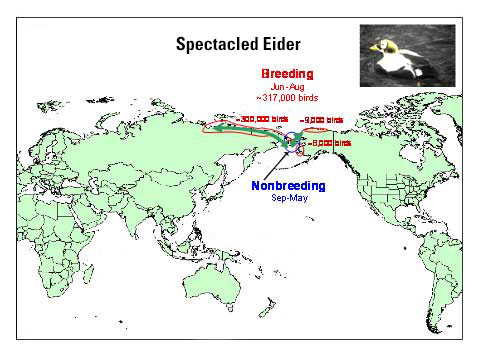Spectacled Eider, Somateria fischeri
High-Priority Species ListSpectacled Eiders breed at relatively low densities and nests can be difficult to detect. Thus, locating and capturing a large sample of breeding birds is difficult and labor intensive. However, eiders have a relatively consistent behavior of defecating on their eggs when flushed from their nests. Thus, fresh fecal samples can be obtained from a large proportion of the nests found without having to capture females.
Sampling locations: Primary locations include Kigigak Island, Tutakoke River and random plot locations used in the nesting eider surveys.
Sampling timeframe: Late May through early July.
Sample demographics: After-second-year breeding females. Methods of capture: Females will be captured on nests using mist nest or bow-traps.
Other targeted species: Sympatric nesting species include, Common Eiders, Black Brant, Northern Pintails, and Emperor Geese.
Supplemental sampling: Hatch year Spectacled Eiders are being captured and banded at Kigigak Island to estimate recruitment. Juvenile waterfowl may be sensitive indicators of viruses present in populations as they have limited immunity. Cloacal swabs will be taken from these live-captured individuals. Small numbers of Spectacled Eider nests are found and monitored in conjunction with work in and around Prudhoe Bay. Opportunistic fecal samples can likely be obtained from these nests. Pooled fecal samples could be obtained from wintering concentrations if access to wintering areas were possible via ship.
Contact: Julian Fischer
Yukon Delta NWR (sampling at Kigigak Island)
University of Nevada Reno: (sampling at Tutakoke River).
Alaska Biological Research, Inc.: (sampling near Prudhoe Bay)
Petersen, M. R., W. W. Larned, and D. C. Douglas. 1999. At-sea distribution of spectacled eiders (Somateria fischeri): 120 year-old mystery resolved. Auk 116:1009-1020
Scribner, K. T., M. R. Petersen, R. L. Fields, S. L . Talbot, J. M. Pearce, and R. K. Chesser. 2001. Sex-biased gene flow in Spectacled Eiders (Anatidae): inferences from molecular markers with contrasting modes of inheritance. Evolution 55:2105-2115.

Ranking Score: 12.0
Asian H5N1 ranking criteria for Spectacled Eider, Somateria fischeri.
Total of partial contact with Asia1 |
Contact with known "hot spot"2 |
Habitat used in Asia3 |
Pop. in Alaska4 |
Can samples be obtained? |
Score |
4.0 |
1.0 |
4.0 |
2.0 |
1.0 |
12.0 |
Over 90% of the world population (approx 300,000) nests in Arctic Russia |
No known use of AI-infected areas |
Breeds moist tundra meadows and near wetlands |
Approximately 9,000 birds breed on the Arctic slope, and 8,000 on the Yukon-Kuskokwim Delta |
Could be difficult to obtain target number |

